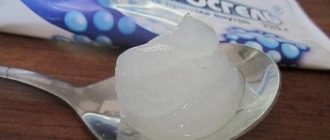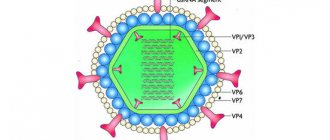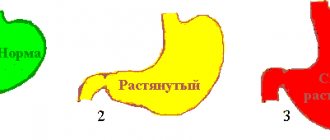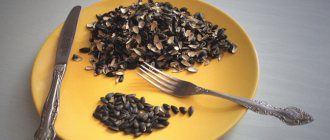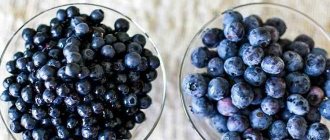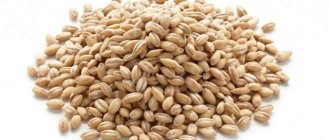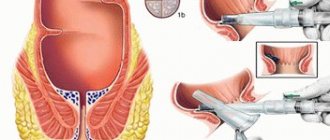Some patients claim that Coca-Cola for rotavirus infection relieves symptoms and fights the pathogen. Before resorting to this method of “therapy”, it is worth figuring out - is it a myth or reality? Therefore, you need to carefully consider how a carbonated drink really affects the patient’s condition.
Rotavirus infections
This is the name given to the process that leads to inflammation of the intestinal tract as a result of infection by a virus. More often the problem is detected in young children.
The disease is transmitted by the oral-fecal route; the likelihood of airborne infection is questioned. Patients experience the first signs after 12 hours:
- A child or adult has a fever.
- Possible fever.
- Nausea and vomiting are noted.
- Diarrhea develops.
- There is pain in the epigastric region.
- Lost appetite.
Infection with rotavirus provokes an increase in the concentration of acetone in the intestinal tissues, which becomes the cause of the clinical picture of poisoning. Typically, the pathology does not lead to complications, but facilitates the penetration of pathogenic bacteria, therefore it is often accompanied by a secondary infection.
In a small child, severe symptoms of intoxication cause electrolyte imbalance. Therefore, professional medical assistance is necessary.
Is it dangerous?
Most intestinal infections are fairly mild and symptoms resolve within 1–3 days. But with vomiting and loose stools, the body loses a huge amount of water and electrolytes. This disrupts the functioning of vital organs and can lead to death. Dehydration is the main danger, so it is important to recognize its signs in time. These include:
- dry mouth and thirst;
- decreased urination (once every 6 hours or less);
- rich color and pungent odor of urine.
In severe cases, there is retraction of the eyes and fontanel (in children under one year old), absence of tears when crying, drowsiness and impaired consciousness.
What's in Coca-Cola?
An interesting fact: the drink was initially positioned as a remedy against nervous and intestinal disorders and was sold in pharmacies. Today, sweet soda is easy to purchase at almost any retail kiosk. Such changes occurred as a result of adjustments to components.
In 1886, Coca-Cola had a 1:3 ratio of cola nuts to leaves. Apparently this was useful. But a lot of time has passed since then and the composition has changed significantly. Now, excessively consuming Cola for rotavirus infection can easily harm the body.
Today it is only approximately known what natural components, in addition to tropical tree extract, are in the product:
- caffeine;
- lemon acid;
- vanilla;
- sugar;
- lime juice;
- water;
- carbon dioxide.
However, there are also secret ingredients, so the exact composition is still unknown. An independent examination was carried out, which showed the presence of:
- calcium;
- phosphorus;
- magnesium;
- potassium;
- sodium
Basically, the only ingredient that is present in Coca-Cola that can kill pathogens is phosphoric acid. But the positive effect is doubtful:
- Concentration is not enough to heal.
- The compound largely destroys bacteria leading to secondary disease, but has little effect on rotavirus infection.
One may come to the conclusion that the drink is useless for flu and intestinal problems. But Coca-Cola against rotavirus will replenish the mineral balance and prevent dehydration.
The high concentration of CO2 makes the product quite aggressive towards the digestive tract. Therefore, it is better not to “treat” children in this way.
Where did the myth about the miraculous properties of cola come from?
This is marketing. It's no secret that a bottle of Coca-Cola can be bought almost anywhere in the world, including the most remote corners of developing countries. (But in these same countries, every ninth child dies before the age of 5, including from diarrhea and dehydration). There is evidence that, thanks to the efforts of the manufacturing corporation, the availability of Coca-Cola in some third world countries is almost greater than clean drinking water and especially ORS (oral rehydration salts).
And given the low level of hygiene and the high prevalence of infectious diarrhea, the need for drinking is extremely high. And Coca-Cola turns out to be the most accessible, safe (from the point of view of infections) drink. Of course, it is better than nothing or poor quality water, which serves as a source of infection.
Most likely, it was from there that travelers brought the myth about the miraculous properties of cola to cure diarrhea. But you and I live in a civilized world where we have access to oral rehydration solutions (ORS).
The effect of Coca-Cola on the gastrointestinal tract
If you regularly drink soda, there are negative consequences:
- Acids irritate the walls of the stomach and intestines, which provokes inflammatory processes.
- High sugar content increases the load on the liver and promotes the release of large amounts of insulin.
- CO2 weakens the valve located at the bottom of the esophagus. As a result, half-digested foods penetrate back into the organ, causing heartburn.
It is impossible to reduce the negative consequences by using the easy option. Manufacturers cheat by pointing out that the product does not contain a sweet component, but instead they use substitutes that also harm the gastrointestinal tract.
Why does Coca-Cola help with rotavirus?
Orthophosphoric acid increases the acidity of the environment, which leads to the destruction of the structure of pathogens. This prevents the proliferation of microorganisms and helps improve the patient’s condition. It also contains sugar, which reduces the urge to vomit.
The benefits of the drink against rotavirus infection have been repeatedly emphasized by Dr. Komarovsky. But it is impossible to cure the disease on your own using exclusively Coca-Cola or Pepsi. Neglect of health can cause death. Competent therapy under the supervision of a doctor is necessary.
How to use Coca-Cola when treating rotavirus infection?
If you decide to drink soda, you need to adhere to certain rules:
- The opened bottle is kept at room temperature for several hours. This helps remove harmful CO2.
- After pouring the liquid into a glass, mix thoroughly, removing any remaining gas.
- The patient should be given Coca-Cola against rotavirus in small portions every 30 minutes.
This method is believed to be safe for the child. But at the same time, the baby’s condition is monitored. If the patient is active, it is allowed to take note of the method, since physical activity will allow you to quickly get rid of caffeine and use up the energy received from soda.
Conclusion
A person can decide for himself what is acceptable for him in treatment.
No one prohibits treatment with medications, but the effectiveness of drinking Cola has also been proven. The main thing is to understand in what doses the drink can be used without harm to health.
Even the ancients noticed that any poison in small doses can be a medicine for humans. And the main thing here is not to make a mistake in quantity. Therefore, if you have even the slightest doubt, you should not test it on your own health. You should carefully understand and understand that what is called dangerous to health does not always have the same effect on the body in small doses.
https://youtu.be/QcKo52Ql7mA
And why is it not worth treating with Coca-Cola?
Many people are familiar with rotavirus infection firsthand: the virus, most often “brought” by a child from kindergarten, can unsettle the entire family for several days. At the same time, nausea, vomiting and diarrhea are often blamed on spoiled foods - it seems that all family members “ate something wrong.” Attempts to treat an intestinal infection with antibiotics do not yield results: as with any viral infections, antibacterial agents are useless in this case. We tell you where rotavirus infection comes from and what to do about it.
Text: Ksenia Akinshina
Contraindications
Rotavirus and Coca-Cola are incompatible if:
- Diabetes. There are about 6 tsp in 1 glass of drink. sweet component.
- Gastrointestinal diseases. Acids, dyes, and flavorings become irritants.
- Obesity. Regular consumption increases the risk of gaining excess weight in 90% of cases.
- Potassium deficiency. Coca-Cola reduces the concentration of the mineral. Among the consequences is the development of paralysis.
- Insomnia. Caffeine increases energy and makes it difficult to fall asleep.
- Caries, pathologies of bone tissue and cartilage. Phosphoric acid destroys tooth enamel and washes the element out of the skeleton.
Among the reasons why it is undesirable to drink soda often is the negative effect on the pancreas and gallbladder. You can provoke the development of cholecystitis or pancreatitis, the treatment of which will take longer than rotavirus infection.
It is not advisable to take Coca-Cola during pregnancy, as there is a risk of miscarriage or premature birth due to the presence of caffeine. And the destructive effect on bone tissue provokes poor formation of the musculoskeletal system in the fetus.
Summarize
If you are faced with a rotavirus infection, you may well try to cure yourself with Coca-Cola. Perhaps this tool will help you. Lack of improvement should prompt the patient to see a doctor.
Remember that it is unacceptable to conduct such experiments on children. This may further affect their health. Doctors do not recommend self-prescribing for intestinal flu.
https://www.youtube.com/watch?v=
The disease is not as harmless as it might seem at first glance. With severe diarrhea and vomiting, the patient requires hospitalization and inpatient treatment. Within the walls of a medical institution they certainly won’t give you Coca-Cola for this.
Reviews
Doctors recommend adhering to restrictions on the use of the drink, as most people doubt the benefits. If the patient is sure otherwise, it can be used to prevent rotavirus infection. In case of severe illness, soda is strictly prohibited, as it provokes dehydration.
People who have already resorted to this method note that cola and rotavirus are compatible. The product really eliminates symptoms and speeds up recovery. But you need to take it in small volumes so as not to cause exacerbation of chronic pathologies.
What about antibiotics?
Antibiotics are not used to treat most intestinal infections, as they are most often caused by viruses. But “bacterial” diarrhea does not always require the prescription of antibiotics: at best they have no effect, at worst they can cause serious harm. Therefore, the detection of blood in the stool (which is typical for bacterial inflammation of the colon) is not a reason to start antibacterial therapy on your own. This is a reason to consult a doctor who will carefully examine the child and, most likely, prescribe a stool test to clarify the specific causative agent of the intestinal infection - and then, based on all available data, decide whether an antibiotic is needed and which one.
That is, giving water and food is all the treatment? In general, yes. The benefits of probiotics, sorbents and zinc (in children over 6 months of age) have recently been actively discussed. Researchers are most skeptical about the effectiveness of probiotics, but sorbents and zinc preparations seem to be able to reduce the duration of diarrhea by about one day. Antidiarrheal drugs for intestinal infections in children are prohibited. Enzymes are not indicated, and immunomodulatory drugs have no proven effectiveness. Thus, treatment comes down to properly watering and feeding the child, as well as monitoring his condition and, if alarming symptoms appear, immediately consult a doctor.
